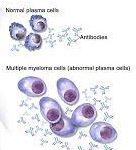
Myeloma or multiple myeloma is a type of blood cancer that develops in the bone marrow from plasma cells. The change in the DNA of the plasma cells when the bone marrow is producing new plasma cells causes myeloma. The abnormal plasma cells produce multiple abnormal cells or myeloma cells.
What are the signs & symptoms?
What are the diagnostic tests for myeloma?
Bone marrow biopsy: The doctor removes fluid or tissue from bone marrow using a needle to look for plasma cells.
Chest X-ray. It uses low doses of radiation to capture inside images of the chest.
MRI: The radio waves and strong magnets help make precise images of the affected area. MRI identifies the size of cancer and other tumors inside the body.
Blood tests: It measures the different kinds of cells in the blood.
Serum albumin and serum beta-2 microglobulin (β2-M): Serum albumin, a blood protein is produced in the liver. It helps to manage blood volume and overall health. β2-M protein helps the immune response of the body.
Lactase dehydrogenase (LDH): Damaged tissues release LDH (enzyme) into the bloodstream. The presence of LDH indicates injury or disease in the body. LDH level determines prognosis, the chance of recovery, and the stages of myeloma.
Fluorescence in situ hybridization (FISH): It is a cytogenetic test that uses a fluorescent dye to detect changes in chromosomes. It helps to know the aggressiveness of myeloma. FISH helps predict the prognosis.
PET scan: It helps to detect the cancer spread. A small amount of a low-level radioactive substance is released into the blood. The substance attaches to the cancer cells. A special camera shows any areas of radioactivity.
How advanced is my myeloma?
The doctor identifies the spread of myeloma or myeloma stage to decide the types of treatment required. The stages are based on the cancer growth or cancer spread. The three stages are based on the level of serum albumin, serum β2-M, LDH, and FISH test.
Stage I: All of the following are applicable:
- Normal LDH
- Serum albumin of 3.5 g/dL or more
- β2-M < 3.5 mg/L
- Myeloma cells have no high-risk chromosome changes (FISH test)
Stage II:
Neither stage I nor stage III.
Stage III:
β2-M > 5.5 mg/L, and one of the following:
- High-risk chromosome changes in myeloma cells
- High LDH
Ask your doctor about these stages in detail.
What are the suitable treatments for me?
Several kinds of treatment are available for myeloma, including radiation, immunotherapy, targeted therapy, chemotherapy, and stem cell therapy.
RADIATION THERAPY
Radiation kills cancer cells. It effectively treats myeloma. The rays are aimed at the affected area from a machine outside the body. It kills only cancer cells.
The common side effects are fatigue, itchy skin, appetite loss (anorexia), and diarrhea (dysentery).
Most side effects may improve after radiation ends. Ask your doctor about what to expect.
CHEMOTHERAPY
Chemo is the primary treatment for myeloma. You can take chemo medicines intravenously or orally. The drugs spread through the body via the blood. Chemo is given in cycles or rounds. Each cycle has a rest time. Chemo is useful if cancer has spread in the body. Chemotherapy may decrease the chances of myeloma recurrence.
The common side effects are fatigue, body pain, and hair loss. These side effects go away gradually after chemo treatment ends. If you experience any side effects, talk to your doctor.
TARGETED THERAPY
Targeted therapy drugs are helpful to treat myeloma. These drugs majorly affect cancer cells and rarely normal cells.
High blood pressure, fatigue, nausea, heart problems, and blood clot are the most common side effects. Talk to your doctor for any help.
IMMUNOTHERAPY
Immunotherapy boosts the immune system to attack the cancer cells. You can administer the drugs intravenously, as a shot, or as pills.
The common side effects are fatigue, headache, constipation, skin rash, and appetite loss.
STEM CELL TRANSPLANT
If any of the above treatments don’t work, the doctor may opt for a stem cell transplant. Initially, the doctor prescribes very high doses of chemotherapy. It destroys cancer cells and stem cells in the bone marrow. After chemotherapy, you will get a stem cell transplant to replace the destroyed cells.
The common side effects are mouth pain, throat pain, nausea, vomiting, and infection.
What are the other treatment options?
The other treatment options may or may not be standard medical treatments. These treatments involve vitamins, herbs, and diet. Discuss with your doctor about other treatment options.
What to expect after treatment?
You may have fear of cancer recurrence. Visit your doctor every three months after the treatment ends. Do not skip follow-up visits. Your doctors will ask you about new symptoms. A physical examination and diagnostic tests may help to check recurrence.
For the first year, the follow-up visits may be every three months. After the first year, follow-up visits might be every six months, and then at once a year after five years.
Dealing with cancer is challenging. Ankr can help you find the best treatment and cut side effects by half! Sign up for free 30-day trial now (https://my.ankr.us/patientSignup) Ankr is the useful Cancer Platform in and around the USA. It offers the best modern treatment for cancer. Hence, improving the quality and life expectancy of the cancer patients.
